 |
THE WEST |
 |
|---|
AFTER THE FALL OF ROME
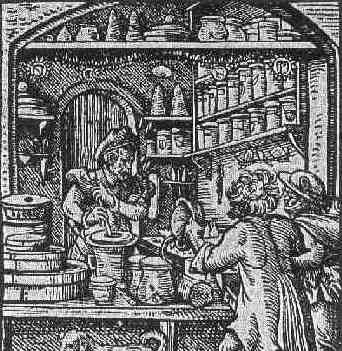
EARLY APOTHACARY SHOP
THE HISTORY OF WESTERN MEDICINE
The history of Western Medicine can be divided roughly into two different sections: Before 1492 (when Columbus sailed the ocean blue) a.k.a. the dark ages, and after. And when dealing with the subject of Medical Cannabis, the second can also be subdivided into pre-and-post O’Shaughnessy (1830’s), whose work in India introduced many of its uses into Western medicine.
AFTER THE FALL OF ROME:

The Dark Ages
A THOUSAND YEARS WITHOUT A BATH: [350-AD to 1492]
Technically speaking, the history of Western Medicine between the time of the fall of Rome (~350) and the physician Paracelsus, should be a very simple one, and quite short. In fact, it could be summarized in two quick sentences:
- It was a thousand years without a bath.
- Technologically speaking, nothing happened, in fact at times it seemed to go backwards.
It wasn’t just a case of technology standing still, it actually went backwards. Buildings were destroyed or just allowed to crumble, the Roman road system (one of the best on earth), as well as their water aqueducts, went without repair etc. But worst of all, even many of their Scientific and Medical textbooks were also lost and forgotten.
Historians have long argued why this happened. I myself was fascinated by Jerret Diamond’s book, “Collapse,” which dealt with just that. How human civilizations collapse and go backwards. But his book, while giving many extremely well documented examples, simply cannot explain what occurred to cause the Dark Ages and Medieval Europe.
In Diamond’s book, everyone of his examples always had a common thread, and that was that someone run out of something, something that could not be replaced.
- In the case of Easter Island, they run out of trees--No trees, no canoes and thus no fishing and thus not enough food.
- In the case of the Maya, their population got too big, and there was no more farmland.
- In the case of the Navaho, the weather went bad, and they simply couldn’t feed themselves.
So what happened? How did a literate people (who had all this technology in writing), simply have lost everything? Again, it almost stifles the imagination. And unfortunately for us, as Western Technology went, so did its knowledge and use of Medical Cannabis. Only one word describes its progress during the Dark Ages, NOTHING. Truly, it would be a Thousand Years Without a Bath!
Not surprising then that one of only two original [such as in non-reproduction of an old Greco-Roman work or a translation of some Arabic text] medical work from this period that we have come across comes down to us via St. Hildegard of Bingen (1098-1179), a woman monk, who wrote on various subjects (including medicine) and according to one author:
“Argued that it was important to strengthen the sick body physically so that it could withstand more easily the attacks of the devil and his assistants.” [B]Of Hemp in her book “The PHYSICA” she wrote:
XI. HEMPOnce more, remember that her herbal was written in the middle of the 12th Century, and in its own way, represented the height of medical knowledge for its day.
“Hemp [hauff] is warm and grows where the air is neither very hot nor very cold, just as its nature is. Its seed is sound, and it is healthy for healthy people to eat it. It is openly gentle and useful in their stomach since it somewhat takes away the mucus. It is able to be digested easily; it diminishes the bad humors and makes the good humors strong. But nevertheless, whoever is weak in the head and has a vacant mind, if that person will have eaten hemp, it easily makes the person suffer pain somewhat in his or her head. However, whoever is sound in the head and has a full mind, it does not harm. Whoever is seriously ill, it also makes that person suffer pain somewhat in the stomach. However, whoever is only moderately ill, it does not cause pain when eaten.
However, let whoever has a cold stomach cook hemp in water, squeeze out the water, wrap it in a cloth, and then place the hot cloth often over the stomach. This comforts the person and restores that place. Also, whoever has a vacant mind, if the person will have eaten hemp, it causes pain somewhat in the head; but it does not cause pain in a sound head and full brain. Also, the cloth made from the hemp heals ulcers and weeping wounds because the heat in the hemp has been tempered.” [C]
"A Treasury of Health by Pope John XXI [era 1277]"
The only other work that we've been able to locate from the Dark ages was (interestingly enough) written by a Roman Catholic Pope, who also happened to have been a medical doctor. Its medical formulations remained useful long after it was originally written. In 1553 an English translation was published.
AS AN ASIDE -- The very fact that a pontif (Pope John XXI was also a physician) would write a Medical Textbook with various references to Hemp, of and of itself, DISPROVES or brings into question those claiming the Church outlawed the use of Medical Cannabis.
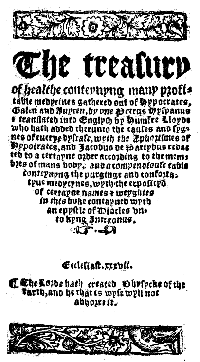
The treasury of healthe conteynyng many profitable medycines gathered out of Hypocrates, Galen and Auycen, by one Petrus Hyspanus [and] translated into Englysh by Humfre Lloyde who hath added therunto the causes and sygnes of euery dysease, wyth the Aphorismes of Hypocrates, and Iacobus de Partybus redacted to a certayne order according to the membres of mans body, and a compendiouse table conteynyng the purginge and confortatyue medycynes, wyth the exposicyo[n] of certayne names [and] weyghtes in this boke contayned wyth an epystle of Diocles vnto kyng Antigonus.
[English] Publication Date: 1553 By (author) Pope John XXI (era 1277) [MORE]
-
Remedies - Agaynst a Carbuncle Capi. LIX
. . . The ioyce of Hempe, afore the fyt taketh away the feuer.
Remedies - Agaynst the scabe and french pokes cap. LXII
. . . Take of red colewortes, fengreke Percely, sothernewod, tansey, strawbery leaues, and suet, brere leaues, plantayn leaues, hempe, redmadder smallage, cransebill, Alam, nuttes, before al thynges let them be sodde~ together in pure whyte wyne, & put therto a lytle hony, giue it vnto the pacient early & late, and anoynte ye wound wtout when he hath dronke of ye sayd potion, & lay theron a lefe of red colewortes & keape the same co~tynually ouer it, it openeth it and hath ben often prouyd.
1450 -- IMPORTANT DATE: Some guy invents the printing press, making mass production of medical books possible. The Dark Ages comes to an end quickly thereafter.
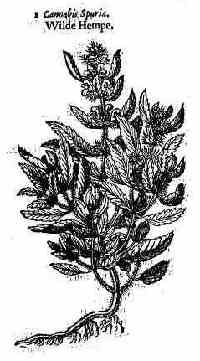
WARNING: ---- No, despite the name this just ain’t the right herb. The problem still exists with us to this day: example, the term “Indian Hemp” as stated in early 20th Century pharmaceutical price and product catalogs could mean either -- Cannabis Indica (meaning Cannabis from the nation of India) or Canadian Hemp, which is a total different species.
|
EVIL MUGWORT REEFER MADNESS ERA MYTH INFORMATION |
 |
MEDICAL CANNABIS -- THE RENASCENCE AND WESTERN MEDICINE:
The following (bit's and pieces), are taken directly from, "The (English Government's) House of Lords, Select Committee on Science and Technology 9th Report." Note the jump from Dioscorides ALL the way to the 1500's --- as if there was nothing in-between.
HISTORY OF THE USE OF CANNABIS
The earliest known reference to cannabis is in Assyrian tablets of the seventh century BC. It has thus been in use for at least 2600 years. . . In Western medicine, it appeared in the Herbal (i.e. pharmacopoeia) of Dioscorides of about 60 AD, and in all subsequent herbals. The 16th century saw a detailed interest in cannabis, with reports of it and its usages being sent back by many travellers to the East, and the number of possible uses given in the herbals doubled. In England, the Herbal of John Gerard (1597) recommended it as it "consumeth wind and drieth up seed [i.e. semen]", and quoted Dioscorides as recommending it for easing the pain of earache and for the treatment of jaundice. Nicholas Culpeper, in his Herbal (1653), gave the same indications for the use of cannabis seeds, and also recommended the decoction of the roots, as this "allayeth inflammations, easeth the pain of gout, tumours or knots of joints, pain of hips . . . "Again, note the almost total lack of references between Dioscorides (60 AD) and the 16th Century.
"In these and other early Herbals, each medicine was said to have multiple uses, often without justification. More critical views ultimately prevailed, but only slowly. Thus by 1788 the New Edinburgh Dispensatory still included three quarters of the entries of Dioscorides, but excluded most animal products. Such exotic remedies as "scrapings of an elephant's tooth", "dust from the walls of a wrestling school" and, remarkably, as a cure for quartan malaria, "seven bed bugs in meat and beans", had been eliminated. The loss of the animal products and most of the minerals left the 1788 New Dispensatory consisting mainly of herbal remedies. There was little change for 150 years, and the British Pharmacopoeia of 1914 included most of the contents of the volume of 1788. But the situation was about to change radically, with the rise of synthetic pharmaceutical chemistry."
"Meanwhile, in 1833 Samuel Carey in his Supplement to the Pharmacopoeia and Treatise on Pharmacology advised that cannabis could be used to make "an agreeable intoxicating drink". This is the only British reference to cannabis as an intoxicant known to us from this period."
"Cannabis was reintroduced into British medicine in 1842 by Dr W O'Shaughnessy, an army surgeon who had served in India. In Victorian times it was widely used for a variety of ailments, including muscle spasms, menstrual cramps, rheumatism, and the convulsions of tetanus, rabies and epilepsy; it was also used to promote uterine contractions in childbirth, and as a sedative to induce sleep. It is said to have been used by Queen Victoria against period pains: there is no actual proof of this at all, but Sir Robert Russell, for many years her personal physician, wrote extensively on cannabis, recommending it for use in dysmenorrhoea. It was administered by mouth, not by smoking, but usually in the form of a tincture (an extract in alcohol). Cannabis extracts were also incorporated in many different proprietary medicines. . . more . . .
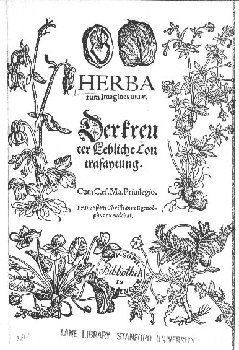 |
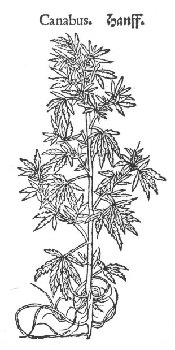 |
Contrary to what many people believe Europe’s renaissance (or rebirth of knowledge), did not start all at once, but instead, seem to go in steps. A little bit over here, a little bit over there, etc. One can say that there was no one on-off switch. Thus instead of boring the reader with a bunch of meaningless events, it might simply be best to allow Medical Cannabis to tell its own story.
What follows are bits and pieces from various Medical Herbals written throughout the Renaissance period, [End of the Dark Ages, to the modern period]. It is suggested that the reader at least skim-read some of them. But BEWARE, due to the vast amount of mis-information (and, it appears to me, out and out ignorance), the reader is advised to treat the given material with a grain of salt, and be a bit skeptical. Please Keep the Following in mind:
- Like the Greeks before them, Europeans simply had the misfortune of living in a geography where only Cannabis Sativa NOT Cannabis Indica was grown. Thus [other than the hemp seeds], they had little chance to learn first hand about its medical uses.
- Additionally, before the beginnings of the Renaissance, only about 2% of the general population was literate, additionally the language of literature was Latin ; all fine and well for the educated minority, but something that made it hard for the average person to read up on the latest news.
- This in turn led to yet another problem -- at least in the beginning there was much confession over exactly what the Hemp plant was. For instance, is what some term, Water-Hemp the same regular hemp? What about Hemp Agrion, or Wild Hemp? The answer is no, no and maybe. Due to the various (more then 300 major) European languages at the time (using Latin as the written language), its hard even to this day to figure out EXACTLY what plant was actually being described in these herbals. [SEE GERARD'S HERBAL FOR MORE ON THE SUBJECT]
- Last of all, the writers of these herbals (like many of us today), no matter how well learned, could not be expected to have first hand knowledge of everything. Obviously they were relying on the written works of others to fill in certain bits and pieces. Which helps explain why so many errors keep repeating themselves over and over again.
|
The reason this chapter is so long is because active newspaper reporters need original first hand documentation on the . . . etc., and can't just our word for it. However, unless the reader is extremely interested in the subject, it is suggested that she only skim read this section. Simply looking over one or two of the Herbals is more than enough to get the general idea. |
|---|
SAMPLE - MEDICAL TEXTS, HERBAL
[FROM THE RENASCENCE 1492-1830'S]
As previously stated; Instead of boring the reader with a bunch of meaningless events, it might simply be best to allow Medical Cannabis to tell its own story. But beware, as someone else put it best; while absolutely nothing happened during the dark ages. From the Renascence on, they at least gave it that old college try -- the problem was that those kids never went to college.
OK, enough with the jokes, but just don't expect anything to come out of this era. Basically everything sounds as if it could have been written by Galen. But please at least look over Gerard's Herbal, the rest can be simply skim-read.
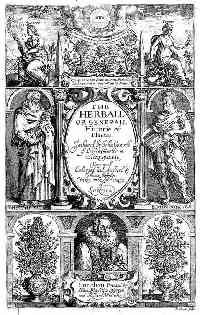
THE HERBALL OR GENERALL HISTORIE OF PLANTES.
Gathered by John Gerarde of London Master in Chirurgerie very much enlarged and amended by Thomas Iohnson citizen and apothecarye of London - Published Date: 1633 By (author) John Gerard [MORE]
CHAP. 238. OF HEMPE.
1 Cannabis mas. Male or Steele Hempe.
2 Cannabis foemina. Femeline, or Female Hempe.
The Description.
1 Hempe bringeth forth round stalkes, straight, hollow, fiue or six foot high, full of branches when it groweth wilde of it selfe; but when it is sowne in fields it hath very few or no branches at all. The leaues thereof be hard, tough, somewhat blacke, and if they be bruised they be of a ranke smell, made vp of diuers little leaues ioyned together, euery particular leafe whereof is narrow, long, sharpe pointed, and nicked in the edges: the seeds come forth from the bottomes of the wings and leaues, being round, somewhat hard, full of white substance. The roots haue many strings.
2 There is another, being the female Hempe, yet barren and without seed, contrarie vnto the 709 nature of that sex; which is very like to the other being the male, and one must be gathered before the other be ripe, else it will wither away, and come to no good purpose.
The Temperature and Vertues.
The seed of Hempe, as Galen writeth in his bookes of the faculties of simple medicines, is hard of digestion, hurtfull to the stomacke and head, and containeth in it an ill iuyce: notwithstanding some do vse to eate the same [...], cum alijs tragematis, with other junkets.
It consumeth winde, as the said Author saith in his booke of the faculties of medicines, and is so great a drier, as that it drieth vp the seed if too much be eaten of it.
Dioscorides saith, That the iuyce of the herbe dropped into the eares asswageth the paine thereof proceeding (as I take it) of obstruction or stopping, as Galen addeth.
The inner substance or pulpe of the seed pressed out in some kinde of liquor, is giuen to those that haue the yellow jaundice, when the disease first appeares, and oftentimes with good successe, if the disease come of obstruction without an ague; for it openeth the passage of the gall, and disperseth and concocteth the choler through the whole body.
Matthiolus saith, that the seed giuen to hens causeth them to lay egges more plentifully.
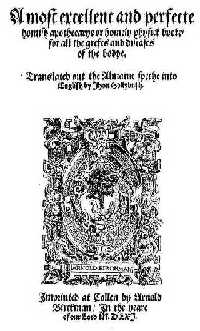
A most excellent and perfecte homish apothecarye or homely physik booke, for all the grefes and diseases of the bodye. Translated out the Almaine speche into English by Ihon Hollybush Publication Date: 1561 By Hieronymus Brunschwig [MORE]
To heale all maner disease of the eares.
If a man haue a sounding or piping in his eares / the same cometh somtyme of a hote slymy fylthynesse / or of a hote slymy moystnesse. He that is so diseased / ought to take pilles de iera picra / & then put oyle of Hempsede warme into his eares / mixt wt a litle vinegre / after yt let him leape vpon hys one legge / vpon that syde / where the disease is / than let hym bowe doune ye eare of that syde / if happely any moysture or fylth would issue out. --- pg 8
Of suppuration or matteringe in the breste.
HE that hath a mattering in ye brest caused of cold . . . . A syrop of Violettes were good for him: but if ye haue not that syrop / tha~ make a milk of Hempsede / of water and hempsede / or els in stede therof take creme / and eat that / thesame cooleth and softeneth the harte wythoute hurte or daunger. After meate ought he to walke a litle / hauinge alwaye a warme cloth before hys mouth / that the ayer do not hurte him: for of the walkinge doth the corruption louse. -- pgs 14,15
But when a man dyd cough / and were strayght aboute the brest and harte / and had heate therewyth / so that it were taken for an apostemacion.
Take~ a dishe full of Hempe sede / put thereto a litle warm water / braye it well / and strayne it wyth warme water / so that it become as a thyn parage. After that when it is colde / geue the patient therof to drinke so muche as he listeth wythout hurte: the same doth mollifye & coole very well / slaketh thyrste / and maketh large aboute the harte. And it is hood to seth that hempsede milke wyth butter / suppe there of wyth a spoune as hote as ye can suffre it / and in thre dayes ye shalbe whole without hurte or payne. It is good also for stich about the hart. --- pg 18
Another drinke for the cough / that cooleth and mollifieth very well / and speciallye apostemes.
Take Hempsede well beaten / mixte wyth water / and strayned through a cloth / so that it waxe euen as milk / drinke therof in the nyght and toward night when ye are thyrstye. . . . This is good also for horsenesse. --- pg 20
Of all diseases of the bellye / and hys partes annexed.
If any person / ether man or woman had a grepinge in hys guttes / specially the frettinge in the great guttes / and he or she were poore: let him take a litle waxe candle / and make therof a crosse vpright / vpon a pece of papir / the bignes of a groate / festened or clyued vpon the belly / and lightened / and a litle glasse set thereon: thesame draweth the payne to it. Or els take a bondel of rawe hempe threde / and seth it in water where are manye ashes / and laye it so warme vpon the belly.
If ye haue no hempe threde / then do as I did when I was called by a woman / that was at the poynt of trauaylinge / and had so greate payne in her bellye / that the chylde lept vp and doune / so that all they that were aboute her / were astonnyed / nether durst anye man minister oughte to her: I bande both her legges aboue the kne hard and faste wyth a bande / and let it so alwaye an Aue Maria / and then losed it agayne a litle space / and band it agayne so oft / tyll the payne was holy taken awaye. -- pg 31
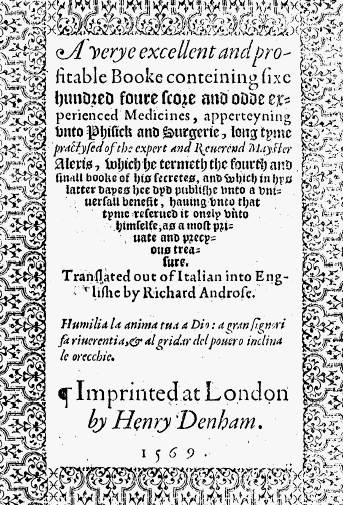
A verye excellent and profitable booke conteining sixe hundred foure score and odde experienced medicines apperteyning unto phisick and surgerie, long tyme practysed of the expert and Reuerend Mayster Alexis, which he termeth the fourth and finall booke of his secretes ... Translated out of Italian into Englishe by Richard Androse. Published Date: 1569 By (author) Girolamo Ruscelli [MORE]
An excellent preseruatiue against the Pestilence and Dropsey.
Take one ounce of the iuyce of gréene nuttes, of the iuyce of Agrimony halfe an ounce, of the iuice of Rew thrée drams, of the iuice of Isope thrée ounces, of the iuice of Hempe foure ounces, meddle them togither, then take of the saide mixture halfe an ounce, of Mumia halfe a dramme, of Sugar Candy halfe an ounce, of Sugar Rosate one dramme, make a lectuarie, of the which, dissolue in good wine the quantitie of a Chestnut, or else in Buglosse water, or of the flowers of Marygolds, and many nights when you go to bed, vse to drinke therof.
To kyll wormes in the eares.
Take of the séedes and gréene leaues of Hempe, & taking out the iuice, put thereof warme into the eares, and you shall sée the effect. Or else, take the Gawle of a Bull, of clarified Hony, of eche lyke quantitie, and boyling it in an earthen vessell, meddle it well togither, and reserue it in a Viall of Glasse, and when néede requireth, being a little warme, put thereof with wooll into the eare, first cleansing the eare from filthe.
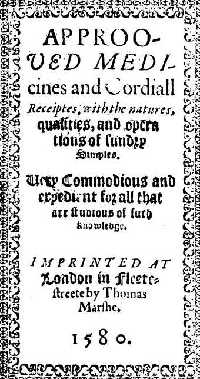
Approoved medicines and cordiall receiptes with the natures, qualities, and operations of sundry samples. Very commodious and expedient for all that are studious of such knowledge. Published Date: 1580 By (author) Thomas Newton [MORE]
Canabis, Hempe.
Hempe seede co~sumeth & dryeth somuch, that if it bee eaten in great quantity, it dryeth seede of Generation: it is hard to be disgested, and maketh ye head ache. --- pg 29
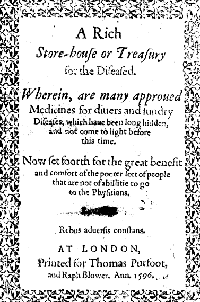 A rich store-house or treasury for the diseased Wherein, are many approued medicines for diuers and sundry diseases, which haue been long hidden, and not come to light before this time. Now set foorth for the great benefit and comfort of the poorer sort of people that are not of abilitie to go to the physitions. Publication Date: 1596 By (author) A.T. practitioner in physicke
[MORE]
A rich store-house or treasury for the diseased Wherein, are many approued medicines for diuers and sundry diseases, which haue been long hidden, and not come to light before this time. Now set foorth for the great benefit and comfort of the poorer sort of people that are not of abilitie to go to the physitions. Publication Date: 1596 By (author) A.T. practitioner in physicke
[MORE]
Cap. 70. A good Medicine for the Raines of a mans backe.
Take Aquauitae, & put therein, a litle Hempe-seede finely beate~, & let it soke in the Aqua-vitae 7 or 8 daies together, then straine it, & let y^ Patient drinke it, & it will help him. Yf you ca~not get Aqua-vitae, the~ take good white wine, or else stale Ale, any of these will serue.
Cap. 87. A very good Medicine for one that is hard bounde in the Belly.
Take a good quantitie of Hempe-seede, and seeth it in faire running Water, and when it is well sodden straine it thorough a fine cloth, and let the Patient drinke a good draught thereof when he goeth to bedde, and this will make him Laxatiue, For it hath beene proued.
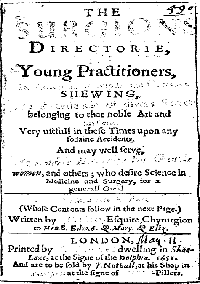
The surgions directorie, for young practitioners, in anatomie, wounds, and cures, etc. shewing, the excellencie of divers secrets belonging to that noble art and mysterie. Very usefull in these times upon any sodaine accidents. And may well serve, as a noble exercise for gentle-women, and others; who desire science in medicine and surgery, for a generall good. Divided into X. parts. (Whose contents follow in the next page.) / Written by T. Vicary, Esquire, chyrurgion to Hen 8. Edw. 6. Q. Mary. Q. Eliz. Publication Date: 1651 By (author) Thomas Vicary [MORE]
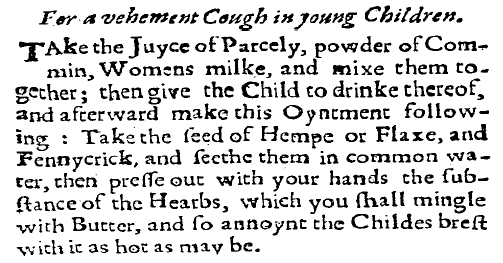
For a vehement Cough in young Children.
Take the Juyce of Parcely, powder of Commin, Womens milke, and mixe them together; then give the Child to drinke thereof, and afterward make this Oyntment following: Take the seed of Hempe or Flaxe, and Fennycrick, and seethe them in common water, then presse out with your hands the substance of the Hearbs, which you shall mingle with Butter, and so annoynt the Childes brest with it as hot as may be. - page 310
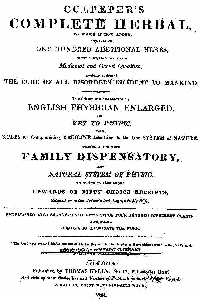
1652 - The Complete Herbal by Nicolas Culpeper (1616-1654)
According to one website: "Nicolas Culpeper (1616-1654) expounded on the relationship of astrology and herbs and the older belief in the "Doctrine of Signatures". This belief extending deep into the distant past herbal traditions of the world maintains that there is a relationship between the way a plant appears and the condition for which it is indicated.
Always the physician of the people, Culpeper was the most hated by his professional colleagues because he violated a solemn oath of London’s College of Physicians by translating from the Latin some of the elitist works of the time, notably the Pharmacopoeia which he retitled A Physicall Directory." [MORE]
The following is taken directly from the book "Culperer's Complete Herbal" (1824), serves to show, just how far behind the West had fallen.
HEMP.
THIS is so well known to every good housewife in the country, that I shall not need to write any description of it.
Time.] It is sown in the very end of March, or beginning of April, and is ripe in August or September.
Government and virtues.] It is a plant of Saturn, and good for something else, you see, than to make halters only. The seed of Hemp consumes wind, and by too much use therof disperses it so much that it dries up the natural seed for procreation; yet, being boiled in milk and taken, helps such as have a hot dry cough. The Dutch make an emulsion out of the seed, and give it with good success to those that have the jaundice, especially in the beginning of the disease, if there be no ague accomplanying it, for it opens obstructions of the gall, and causes digestion of choler. The emulsion or decoction of the seed stays lasks and continual fluxes, eases the cholic, and allays the troublesome humours in the bowels, and stays bleeding at the mouth, nose, or other places, some of the leaves being fried with the blood of them that bleed, and so given them to eat. It is held very good to kill the worms in men or beasts; and the juice dropped into the ears kills worms in them; and draws forth earwigs, or other living creatures gotten into them. The decoction of the root allays inflammations of the head, or any other parts; the herb itself, or the distilled water thereof doth the like. The decoction of the root eases the pains of the gout, the hard humours of knots in the joints, the pains and shrinking of the sinews, and the pains of the hips. The fresh juice mixed with a little oil and butter, is good for any place that hath been burnt with fire, being thereto applied.--Pg. 91
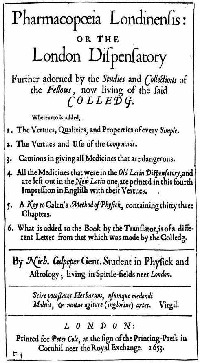
Pharmacopoeia Londinensis, or, The London dispensatory further adorned by the studies and collections of the Fellows, now living of the said colledg ... / by Nicolas Culpeper Published Date: 1653 Author: Royal College of Physicians of London.
[MORE]
SEEDS barely mentioned by the Colledg are, of
Colledg] Sorrel: Agnus Castus: Marshmallows: Bishops weed true and common: Amomus: Dill: Angellica: Annis: Rose-seeds: Smallage: Columbines: Sparagus: Arach: Oates: Orrenges: Burdocks: Bazil: Barberries: Cotton: : or Kneebolly: Hemp . . . [etc.] -- pg 47
Syrupus de Agno Casto. Pag. 50. In the L. Book. O R Syrup of Agnus Castus.
The Colledg. Take of the seeds of Rue, and Hemp, of each half a drachm; of Endive, Lettice, Purslain, Guords, Melones, of each two drachms; of Fleawort half an ounce, of Agnus Castus four ounces, the Flowers of Water-Lillies, the Leaves of Mints, of each half a handful; Decoction of seeds of Lentils, and Coriander seeds, of each half an ounce, three pound of the Decoction, boyl them all over a gentle fire til two pound be consumed, ad to the residue being strained, two ounces Juyce of Lemmons, a pound and an half of white Sugar, make it into a Syrup according to art.,--- pg 102
Oleum [oil] Chrysomelinum.
The Colledg] Is prepared in the same manner of Apricocks; so is also Oyls of the Kernels of Cherry , Peaches, Pine-nuts, Fistick nuts, Prunes the seeds of Orienges, Hemp; Saffron, , Cucumers, Guords, , Dwarf Elder, Henbane, Lettice, Flax, Melones, Poppy, Parsly, Rhadishes, Rapes, Ricinum, Sesani, Mustard Seed, and Grape stones.
Culpeper] A. Because most of these Oyls is out of use, I took not the pains to quote the Vertues of them; if any list to make them, let them look the Simples and there they have them; if the Simples be not to be found in the Book, there are other plentiful Medicines conducing to the cure of all usual diseases which are. -- pg 154
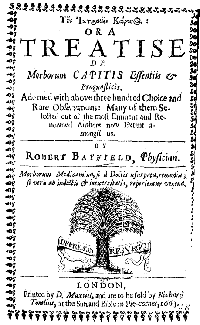
Tes iatrikes kartos, or, A treatise de morborum capitis essentiis & pronosticis adorned with above three hundred choice and rare observations ... Published Date: 1663 By (author) Robert Bayfield [MORE]
CAP. XC. De Ulceribus aurium, & vermibus.
ULcera aurium, Ulcers of the ears, arise from those things that either pour forth pus or matter, or else such as by their acrimony and tartness are of a corroding nature.
. . . Vermes, worms, discover themselves by the corroding pain, restlesness, and other such like conjectural Symptoms.
Necantur unguento ex axungia capi, & oleo coryli, cum gr. ii. Mercurii dulcis misto: This medicine following is highly commended. Rx Olei amygdal. amar. succi apii, centaurii minor. ana, {ounce} ii. aceti, {dram} ii. Bulliant parum, deinde adde myrrhae, aloes, ana, {scruple} i. M. Instillentur in aurem. Also the decoction of Hemp dropt into the ear is very effectual for the killing of Worms. Hitherto of the diseases of the ears: Next follow the symptomes. --- pages 134,135
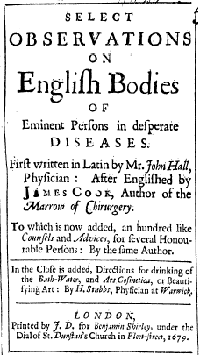
Select observations on English bodies of eminent persons in desperate diseases first written in Latin by Mr. John Hall ... ; after Englished by James Cook ... ; to which is now added, an hundred like counsels and advices, for several honourable persons, by the sam
Published Date: 1679 By (Author) John Hall [MORE]
COUNS. XXV. Vlcers of the Bladder.
For her by another eminent Physician. Take Mastick wood {ounce}iii. Sarsaparilla {ounce}vi. Liquoris {ounce}ii. after rightly prepared, boyl them in four gallons of Wort till a gallon be wasted; then strain out the Ingredients, and add a gallon of fresh Wort to it. After ready, use it for ordinary drink. Take of the four greater cold Seeds, each {ounce}ss. Seeds of Plantain, Water-lillies, and Hemp, each {dram}iii. boyl them in Barly-water lb vi to lb iii. to which add Plantain water lb ss. Penidies, sufficient quantity to sweeten it; and make an Emulsion. Take Troches of Gordon {ounce}ii. make a Pouder. Take of the Emulsion first in the morning, also an hour before supper, and at night going to bed, half a pint or little less; and in the morning and night-draughts, put in as much of the Pouder as will lie on a shilling. --- pg 228
COUNS. LXVI. Mother.
For the Right Honourable, the Lady Katherine Brook, for Hysteric Vapours, which did much afflict the Head and Neck, by Dr. Bates, and others. Sept. 12. 1666. was prescribed what follows: . . . . Take Flowers of red Roses, Elder, each M i. Betony, Rosemary, Cowslips, each M ss. Hemp seed {ounce}i. Juniper berries {ounce}ii. Persia Nuts 12. ther, and besprinkle them with Rose-vinegar, and boyl them in Cream lb iss. to the wasting of the Serum; after strain them, and add Oil of Amber {dram}iss. and make an Ointment. The part of the Head pained being shaved, was anointed twice a day, by which she found much advantage. -- pages 284, 285
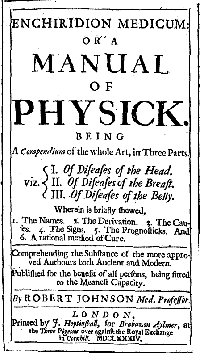
Enchiridion medicum, or, A manual of physick being a compendium of the whole art, in three parts ... : wherein is briefly shewed 1. the names, 2. the derivation, 3. the causes, 4. the signs, 5. the prognosticks, and 6. a rational method of cure ... / by Robert Johnson, Med. professor.
Published Date: 1684 By (Author) Robert Johnson [MORE]
CHAP. XI. Of the Yellow Jaundice.
Take of Rhubarb, the Roots of Madder, Smallage, the greater Celandine, of each one ounce; the Flowers of Broom one handfull; Hemp-seed two ounces; the Seeds of Anise, Parsley and Columbines, of each half an ounce; Saffron two drachms; white Tartar three drachms; let them be cleansed, bruised and boiled in White-wine, and Fountain water, of each three pints, till the third part be boiled away, then strain it, and add the best Manna, Syrup of Succory with Rhubarb, of each three ounces; mix it.
Let the sick take four spoonfulls of this three times a day, till the viscous phlegm and Choler be sufficiently evacuated, and the natural colour of the body restored. --- pg 205
. . . . Take the Roots of Scorzonera, Juniper, of each two ounces; Roots of Master-wort, Sassaphras, of each half an ounce; Berries of Juniper and Bays, of each one ounce and half; Seeds of Nettles, Hemp and Columbines of each one ounce; shavings of Harts-horn three drachms; the tops of Carduus, Scordium, Scabious, the lesser Centaury, of each one handfull; let them be cleansed, bruised and boiled in two quarts of Fountain-water, till half of it be boiled away; then strain it, and add Syrup of the juice of Carduus four ounces; Treacle-water two ounces; Salt of Tartar vitriolated two drachms; mix it, and give four spoonfulls every two or three hours. -- pg 206
Soap of any sort, conduceth to the cure of the Jaundice, upon a twofold account, both by reason of its fixt lixivial Salt, and also by reason of its fatness or oil; for the Lixivial Salt doth correct and diminish the over volatileness and spirituousness of the vitiated Choler, and the oil doth blunt the sharpness of the volatile and spirituous Salt ruling in Choler. -- pg 207
The following mixture is very effectual.
Take of Hemp-seed two ounces; Soap two drachms; bruise the seed, and boil it in half a pint of new Milk, till half of it be consumed; then strain it, and add Syrup of Saffron half an ounce; tincture of Saffron two drachms; Laudanum opiatum four grains; mix it, and give half of it in the morning fasting, and the remainder at night, going to bed.
CHAP. XXII. Of Extraordinary Pissing, &c.
Take the Roots of China, Sarseparilla, Comfry, Plantain, red Sanders, of each two ounces; Liquorish, red Roses, Hemp-seed, of each one ounce; Raisins of the Sun stoned four ounces; let them be cleansed, bruised and boiled in a Gallon of Fountain-water, till half of it be boiled away, then strain it, and keep it for use. -- pg 271
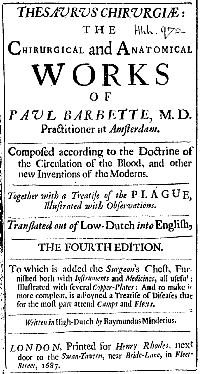
Thesaurus chirurgiae : the chirurgical and anatomical works of Paul Barbette ... composed according to the doctrine of the circulation of the blood, and other new inventions of the moderns : together with a treatise of the plague, illustrated with observations / translated out of Low-Dutch into English ... ; to which is added the surgeon's chest, furnished both with instruments and medicines ... and to make it more compleat, is adjoyned a treatise of diseases that for the most part attend camps and fleets ; written in High-Dutch by Raymundus Minderius.
Published Date: 1687 By (author) Paul Barbette [MORE]
Medicines in Burning.
Roots of White Lillies, Liquoras; Leaves of Bete, Coleworts, Hemp, Onions, Garlick, Henbane, Tabacco, Leeks, St. John's-wort; Flowers of Camomile, Melilot, Elders; Seeds of Quinces, of Line; Camphire, Myrrhe, Olibanum, Soot,
CHAP. VII. Of all sorts of Fluxes; as also the Tenasmus, or vain endeavour of going to stool; and the Haemorrhoid or Piles, and Marisca's or sore Fundaments.
. . . Yet must you not put in any greasie Fat, or any Oyl of Olives, because they hinder healing; and all Oyl, except that of Linseed, Poppies, Hemp and Almonds, is very sharp; and you will find, that if any drop of Oyl of Olives should chance to fall into your Eye, no Juyce of Oranges or Limons is so strong as to exceed the acrimony of that Oyl. But of this Oyl more will be said in the next Chapter, to which I therefore refer you. If you would have your Clyster yet milder and more sanative, you may beat a yolk or two of new-laid Eggs, and mix them with it; though I have contented my self with the Ingredients before mention'd, and found great benefit thereby. Else you may in this case use for a Clyster the Cremor hordei, mixt with yolks of Eggs beaten in it; which is also very good to wash out the bowels. -- page 76
CHAP. IX. Of the Chirurgical means of staunching blood, of Wound-balsoms and plaisters, of Wound-drinks, and remedies for Burnings.
Item, take Cumphrey well cleansed, cut it small, add to it one or two of the Vulnerary Herbs, such as you may meet with in the field, as Pyrola or Winter-green, Yarrow, Plantain, Fluellin, Orpin, Consound, Sanicle, Bugle, &c. Boil this in Linseed-oyl and a little Wine, until the Wine is boiled away; and this being strained, put to it some raw Honey and one or two well beaten yolks of Eggs, (according to the quantity you make) and a little Turpentine, and so thrust it, with some Hemp or Flax dip in it, into the wound.

Medicinal experiments, or, 'A collection of choice and safe remedies' for the most part simple and easily prepared, useful in families, and very serviceable to country people -- Published Date: 1693 By Robert Boyle. [MORE]
VII. For the Jaundice.
Take two or three Ounces of Semen Cannabis (Hempseed) and boil them till the Seeds (some of them) begin to burst, and a little longer, in a sufficient quantity of New Milk, to make one good Draught; which the Patient is to take warm, renewing it, if need be, for some days together. -- pg 644.
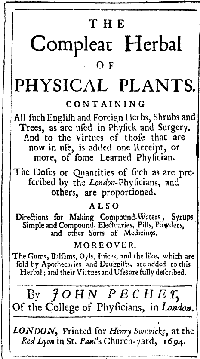
THE COMPLETE HERBAL OF PHYSICAL PLANTS By John Pechey, Of the College of Physicians, in London. Published Date 1694 By (author) John Pechey [MORE]
With reference to Medical Cannabis, the herbal states the following:
Hemp, in Latin Cannabis Sativa. -- The Seed of it boyl'd in Milk, is good for a Cough: And five or six Ounces of it taken, cures the Jaundice: An Emulsion of the Seeds does the same. The Juice of the Herb, and of the green Seed, cures Pains and Obstructions of the Ears. 'Tis suppos'd by some, that it extinguishes Venery; but the Persians use it now-a-days, fried, and mix'd with Salt, to provoke the same. The Oyl of the Seeds, mix'd with a little Wax, is excellent to take out the Pain and Fire in Burns. Galen reckons, that the Virtues of Hemlock and Hemp are much the same. -- Pg 100
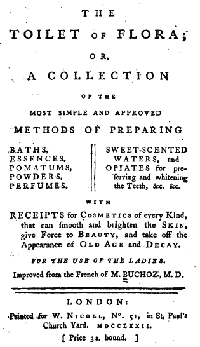
THE TOILET OF FLORA; OK, OK, I know that a book with that kind of title doesn't sound right, but just look at the sub-title: OR A Collection of the Most Simple and Approved METHODS OF PREPARING - Baths, Essences, Pomatums, Powders, Perfumes, Sweet-Scented Waters, and Opiates for preferving and whitening the Teeth, Etc. Etc. With recepipts for cosmetics of every kind, that can smooth and brighten the skin, give force to beauty, and take off the appearance of OLD AGE and Decay. For the use of the Ladies. Improved from the French of M. Buchoz, M.D. Published Date; 1779 [MORE]
9- Receipt to thicken the Hair, and make it grow again on a bald part.
Take roots of a maiden vine, roots of Hemp, and Cores of soft Cabbages, of each two handfuls; dry and burn them; afterwards make a lye with the athes. Before you wash your head with this lye, the part should be rubbed well with honey, and this method perfitted in for three days together.
14- A FLUID TO MAKE THE HAIR GROW
Take the tops of Hemp as soon as that plant begins to appear abouve ground, and infuse, them four and twenty hours in water. Dip the teeth of the comb in this fluid, and it will certainly quicken the growth of the hair.

The Anatomy of Human Bodies, comprehending the most modern discoveries and curiosities in that art to which is added a particular treatise of the small-pox & measles : together with several practical observations and experienced cures ... / written in Latin by Ijsbrand de Diemerbroeck ... ; translated from the last and most correct and full edition of the same, by William Salmon ... Published Date: 1694 By (author) Ysbrand van Diemerbroeck [MORE]
Rx. Herbs, Betony, Vervain, Marjoram, Plantain an. M j. Lettice M iiij. Flowers of Roses, Melilot, Dill, Camomil, an. M j. Hemp and Coriander-seed an. {ounce} s. Common-water q. s.
After Fomentation keep the Head well covered from the cold Air. But this Fomentation will not be proper before the Body be well purged, and some Blood be taken away." --- Page 174
Rx. Root of white Lillies {dram}j. s. Leaves of Beets, Mallows, Mercury, Althea, Flowers of Camomil, an. M. j. Pale Roses M. s. Fengreek Meal {ounce}j. s. The inner Part of one Swallows Nest powdered, Water q. s. Boil them into the Form of a Poultis; to which add Oyl of Camomil {ounce}ij. Mix them for a Cataplasm.
If there be any likelihood of Maturation, add thereto.
Fat Figs no vij. or viij. Meal of the Root of Althea, Hemp-seed, Pulp of Cassia, Oyl of Lillies an. {ounce}j." --- Page 220

Western Medicine:
Pre - O'Shaughnessy uses of Cannabis:
Although the Hemp plant (from which we obtain cannabis), was extensively grown throughout Europe as an industrial crop (for cloth, rope, paper, etc.), and in fact the very word “Canvas” comes to us from the word, Cannabis. It is interesting to note, that Western Medical doctors, seemed to have given it little notice. This is not to say, that they made no use of Cannabis, Cannabis made its way into numerous Medical Herbals and Pharmacopoeias. However, the long and the short of it all is that it’s MAJOR medical uses were ALL but ignored by Western Doctors until the time of O’Shaughnessy.
To give one example, to help emphasize the point. The National Library of Congress, which is one of the best medical libraries in North American and probably on planet Earth, houses and has indexed only one book and seven pre-1840 (meaning pre-O’Shaughnessy) medical articles which make any mention of Medical Cannabis and its medical uses. These are as follows:
- Date 1630 [Book] “In Michaelis Joannis Paschalis methodum curandi scholia. Addita in extremo operis disputatio medica, an cannabis, et aqua, in qua mollitur, possint aërem inficere. Ed. novissima “ Author Pereda, Petrus Paulus
Publisher sumpt. J. Cardonii - Place of Publication Lugduni
Edition / Pagination 7 p. l., 212 ff., 8 l.
Type Monograph - ID Number 21208101150
- Date 1803 “De cannabis vi medica” Author Seidenschnur, Michaelis jacobus
Publisher ex off. Batheana - Place of Publication Halæ
Edition / Pagination 16 pp. - ID Number 11208541430
- Date 1834 “Ueber die Haschischa oder das Kraut der Fakire. Nach dem Arabischen des Tokyy Eddin Makrizi von Dr. v. Sontheimer” - Author Makrizi, T. E.
Journal Wissensch. Ann. d. ges. Heilk. - Place of Publication Berl.
Edition / Pagination xxviii, 293-305 - ID Number 10206911170
Date 1834-42 - “Case of tetanus cured by the extract of hemp” - Author Esdaile, J. Journal Tr. M. & Phys. Soc. Calcutta Edition / Pagination viii, pp. cccxviii-cccix Ref Note Also: Tr. M. & Phys. Soc. Bengal, Calcutta, 1838-40, 120. ID Number 11403801380
- Date 1838-40 - “On the preparations of the Indian hemp, or gunjah (Cannabis indica): their effects on the animal system in health, and their utility in the treatment of tetanus and other convulsive diseases “ - Author O'Shaughnessy, W. B.
Journal Tr. M. & Phys. Soc. Bengal - Place of Publication Calcutta
Edition / Pagination 71-102, 1 pl.
Ref Note Also: India J. M. & Phys. Sc., Calcutta, 1840, n. s., v, 1-12.
Ref Note Also: Tr. M. & Phys. Soc. Calcutta, 1842, viii, pt. 2, 421-461.
Ref Note Also: Prov. M. & S. J., Lond., 1843, v, 343; 363; 397.
ID Number 10206911200
- Date 1838 - “Note sur le hatchi “ - Author B., A.
Journal J. de chim. méd., etc. - Place of Publication Par.
Edition / Pagination 2. s., iv, 61 - ID Number 10206901380
Date 1839 - “On the preparations of the Indian hemp, or Gunjah (Cannabis indica); their effects on the animal system in health, and their utility in the treatment of tetanus and other convulsive disorders” - Author O'Shaughnessy, W. B. Publisher Bishop's College press
Place of Publication Calcutta - Edition / Pagination 46 pp.
Pamphlet Note [P., v. 1026.] - ID Number 11002181260
- Date 1839 - “Cataracte lenticulaire guérie au bout de vingt jours par le Cannabis sativa (chanvre) administré homoeopathiquement” - Author Bron,
Journal Ann. d'ocul. - Place of Publication Brux.
Edition / Pagination ii, 101-104 - ID Number 10207611390
Thus we should all be thankful, that O’Shaughnessy made his voyage to the Bengal
FOOTNOTES:
[B]- A Short History of Medicine by Erwin H. Ackerknecht
[C]- Hildegard Von Bingen’s PHYSICA, translated from the Latin by Priscilla Throop
[D]- Information taken from the book, “An Herbal” (1941) Edited by S.V. Larkey
WANT TO KNOW MORE:
Due to space / download time considerations, only selected materials are displayed. If you would like to obtain more information, feel free to contact the museum. All our material is available (at cost) on CD-Rom format. antique_andy@catholic.org
THE RENASCENCE Back to the Last Section |
 BACK TO CHAPTER 2 |
THE RENASCENCE On to the Next Section |